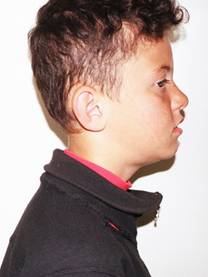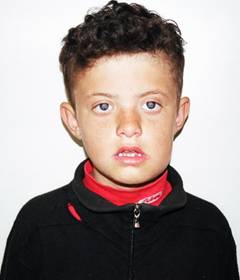


MINOR PHENOTYPIC FEATURES HELPED TO DIAGNOSE THE XYY SYNDROME: A CASE REPORT
Sukarova-Angelovska E*, Kocova M, Ilieva G, Angelova D, Sredovska A
*Corresponding Author: Dr. Elena Sukarova-Angelovska, Pediatric Clinic, Medical Faculty, Vodnjanska 17, 1000 Skopje, Republic of Macedonia; Tel.: +38970358582; Fax: +3892313224; E-mail: ESukarova@doctor.com
page: 63
|
|
CLINICAL REPORT
The proband is a 10-year-old boy, the second child in a family of unrelated parents. Their first and third children are healthy girls without developmental or behavioral problems. At the time of delivery of the proband, the mother was 25 and the father was 31 years old. The father has been described as having border-line intelligence and being a violent man prone to frequent temper tantrums. Other family history was unremarkable.
The pregnancy was uneventful and ended in a normal delivery at the 40th week of gestation. The boy’s length and weight at birth were normal (3500 gr, 51 cm), as was the Apgar score (9/10 at 1 and 5 min., respectively). Delayed motor development was evident during the first years: he started walking on his own at 2.5 years, spoke his first words at 3 years, and later on had difficulties in constructing complex sentences. He attended the first two years of regular primary school, but his scholastic achievements were poor and he was transferred to a special school. According to his mother he is an obedient boy most of the time but cannot make decisions on his own. However, he has fits of violent behavior, gets angry upon provocation, and starts fights without reason. Although he suffered several episodes of upper respiratory infections, he was generally a healthy boy.
At referral he was 12 years old, his height was 153 cm (75‰, age range 135-160 cm), which was above his predicted height at a 25% curve line according to the Tanner growth charts. His weight was 37 kg (50‰, age range 28-55 kg), which gives an impression of a tall and slender body composition. He had thin arms and legs with proportional length with his body. His head circumference was 23.0 cm (age range: 19.8-22.5 cm). Minor dysmorphic features include a long face, high forehead, wide nasal root, widely spaced and protruding eyes, short upturned philtrum, and a wide mouth. His ears were long, posteriorily rotated and protruded. His neck was long and he had flopping shoulders. Mild kyphoscoliosis was accompanied by smaller and elevated scapula on the left side. His fingers and toes were long with a bilaterally incurved fifth finger. His joints were hyper mobile and he had long and hyper convex nails. The penis and testes were normally developed and prepubertal.
His IQ was 70. He had difficulties in fine motor coordination, especially of the fingers. His vocabulary was poor: therefore he tried to communicate with gestures. During the examination he was hyperactive, hardly following some of the procedures. Psychological examination showed that he suffered from uncontrolled outbursts if his wishes were not satisfied and he showed some degree of violent behavior without any reason.
Ultrasound examination of the heart, kidneys and abdomen gave normal results. Chromosomal evaluation was indicated due to his mental retardation, minor dysmorphic stigmata, specific behavior and familial occurrence of mental retardation.




|
|
|
|



 |
Number 27
VOL. 27 (2), 2024 |
Number 27
VOL. 27 (1), 2024 |
Number 26
Number 26 VOL. 26(2), 2023 All in one |
Number 26
VOL. 26(2), 2023 |
Number 26
VOL. 26, 2023 Supplement |
Number 26
VOL. 26(1), 2023 |
Number 25
VOL. 25(2), 2022 |
Number 25
VOL. 25 (1), 2022 |
Number 24
VOL. 24(2), 2021 |
Number 24
VOL. 24(1), 2021 |
Number 23
VOL. 23(2), 2020 |
Number 22
VOL. 22(2), 2019 |
Number 22
VOL. 22(1), 2019 |
Number 22
VOL. 22, 2019 Supplement |
Number 21
VOL. 21(2), 2018 |
Number 21
VOL. 21 (1), 2018 |
Number 21
VOL. 21, 2018 Supplement |
Number 20
VOL. 20 (2), 2017 |
Number 20
VOL. 20 (1), 2017 |
Number 19
VOL. 19 (2), 2016 |
Number 19
VOL. 19 (1), 2016 |
Number 18
VOL. 18 (2), 2015 |
Number 18
VOL. 18 (1), 2015 |
Number 17
VOL. 17 (2), 2014 |
Number 17
VOL. 17 (1), 2014 |
Number 16
VOL. 16 (2), 2013 |
Number 16
VOL. 16 (1), 2013 |
Number 15
VOL. 15 (2), 2012 |
Number 15
VOL. 15, 2012 Supplement |
Number 15
Vol. 15 (1), 2012 |
Number 14
14 - Vol. 14 (2), 2011 |
Number 14
The 9th Balkan Congress of Medical Genetics |
Number 14
14 - Vol. 14 (1), 2011 |
Number 13
Vol. 13 (2), 2010 |
Number 13
Vol.13 (1), 2010 |
Number 12
Vol.12 (2), 2009 |
Number 12
Vol.12 (1), 2009 |
Number 11
Vol.11 (2),2008 |
Number 11
Vol.11 (1),2008 |
Number 10
Vol.10 (2), 2007 |
Number 10
10 (1),2007 |
Number 9
1&2, 2006 |
Number 9
3&4, 2006 |
Number 8
1&2, 2005 |
Number 8
3&4, 2004 |
Number 7
1&2, 2004 |
Number 6
3&4, 2003 |
Number 6
1&2, 2003 |
Number 5
3&4, 2002 |
Number 5
1&2, 2002 |
Number 4
Vol.3 (4), 2000 |
Number 4
Vol.2 (4), 1999 |
Number 4
Vol.1 (4), 1998 |
Number 4
3&4, 2001 |
Number 4
1&2, 2001 |
Number 3
Vol.3 (3), 2000 |
Number 3
Vol.2 (3), 1999 |
Number 3
Vol.1 (3), 1998 |
Number 2
Vol.3(2), 2000 |
Number 2
Vol.1 (2), 1998 |
Number 2
Vol.2 (2), 1999 |
Number 1
Vol.3 (1), 2000 |
Number 1
Vol.2 (1), 1999 |
Number 1
Vol.1 (1), 1998 |
|
|

